


The Mekong River is a vital waterway that stretches over 4,500 kilometers through Southeast Asia, supporting the social, cultural, and economic livelihoods of the region. With over 1,200 species of fish, the river has historically played a crucial role in preventing starvation during times of drought and crisis. However, the Mekong is facing significant challenges, both ecologically and politically. In recent years, China has constructed 11 dams along the river, while Laos and Cambodia are also building dams and barrages downstream. These countries aim to capitalize on hydropower and sell electricity to China, Thailand, and Vietnam. While this development may provide economic benefits, it disrupts the river‘s complex ecosystem and threatens the fish population‘s survival.
The dams obstruct the fish‘s migratory path, putting their conservation and community fisheries at risk. Moreover, the Mekong Delta, located in South Vietnam, is experiencing a range of problems affecting its agricultural productivity and food security. Severe droughts, exacerbated by the dams, along with the impacts of climate change, have led to the degradation of rice quality. The dams also contribute to the delta‘s sinking, as excessive freshwater extraction worsens the land subsidence. Rising sea levels pose an additional threat to the delta, which is situated just above sea level. The Mekong Delta is not only important for agriculture but is also home to endangered species such as monkeys, tigers and elephants. Additionally, illegal sand mining poses a significant challenge. Sand extraction, driven by the international sand mafia, disrupts the natural sediment supply from the upper reaches of the Mekong River, exacerbating the problems faced by the delta.
These ecological challenges and the exploitation of the river for economic gain have turned the Mekong into a political and economic battleground for multiple countries. Climate change further compounds the threats faced by the river and its delta. To ensure the long-term sustainability of the Mekong, it is crucial for stakeholders to prioritize ecological preservation, mitigate the impacts of dam construction, promote sustainable practices, and address the pressing issues of rising sea levels and illegal sand mining.
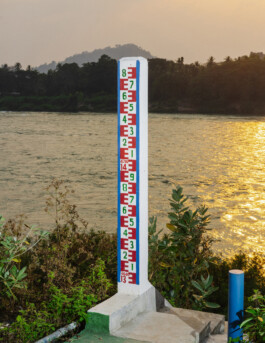
Mekong at the Si Phan Don in Laos.
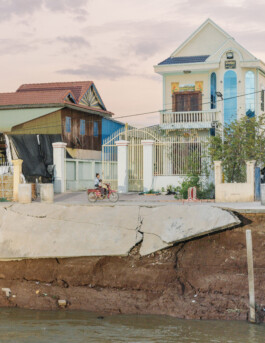
Prek Thi, Roka Kpos district, Cambodia. On January 17 2023, Prek Thi was affected by a landslide, with six houses collapsing into a creek and another requiring relocation.
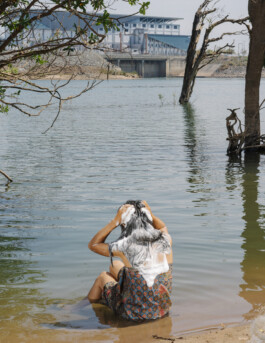
Woman washing her hair in front of the Don Sahong Dam. The Dam, operational since January 2020, is a hydroelectric facility on the Mekong River in Laos, located near the Laos-Cambodia border. It exports most of its electricity to Thailand and Cambodia, despite controversy over its environmental impact and potential threats to fish migration routes and endangered species such as the Irrawaddy dolphin.
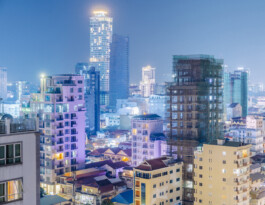
Phnom Penh’s construction frenzy is fueling the need for sand dredging, the practice of sucking up debris from riverbeds.
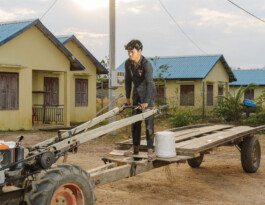
Residents of New Kbal Romeas, near Stung Treng in Cambodia, were affected by the Lower Sesan II hydropower dam construction. Most were Bunong indigenous people, deeply connected to their land. Some relocated to this new settlement, while others resisted moving.
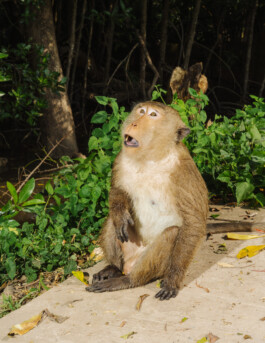
Monkey at a Mangrove Forest in the Mekong Delta. Mangrove deforestation is particularly devastating given the vital ecological role these forests play for surrounding communities.
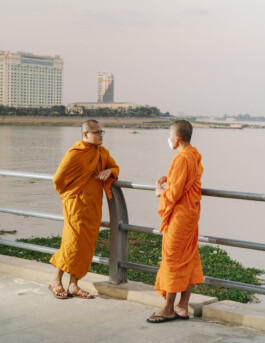
Monks in Phnom Penh, Cambodia, reside at the confluence of two vital tributaries, the Tonle Sap River and the Bassac, where they merge with the Mekong.
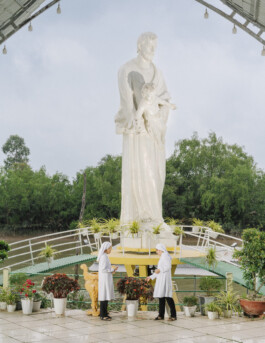
Thanh Tam Church in Rach Vop, Vietnam. After a landslide took part of the church into the Mekong, it was rebuilt and protected against erosion using mainly coconut trees. The big statue shows Saint Joseph and is intended to protect the church from future landslides.
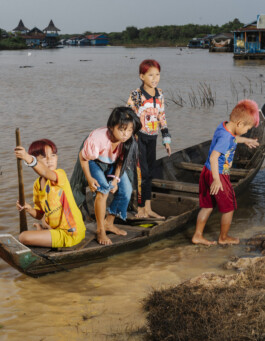
Children from the Vietnamese community at Chong Khneas, Tonlé Sap, Cambodia. As stateless people, the ethnic Vietnamese on Tonlé Sap do not have the same protection and privileges as the citizens of Cambodia. They are not allowed to purchase land, their access to education is limited, and they are subject to arbitrary taxes and abuse by the local government. This denial of privileges results in a large population of stateless Vietnamese huddling in communities along the Tonlé Sap lake in floating villages.
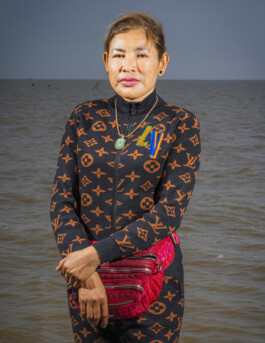
Local worker at a crocodile farm at Chong Khneas, Tonlé Sap. As fishing has decreased massively in the last few years, most locals are forced to earn a living through tourism or crocodile farming.
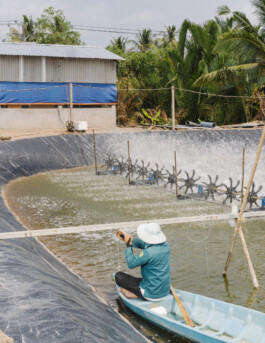
Shrimp farm in the Tra Vinh province in Vietnam. This is the most downstream part of the Mekong delta, where coastal salinity intrusion and the river’s freshwater produces perfect conditions for shrimp farming. Over the last decade, agricultural industrialists and small farmers converted much of the delta’s coastal zone into shrimp farms. Like rice, the delta’s shrimp is sold all over the world.
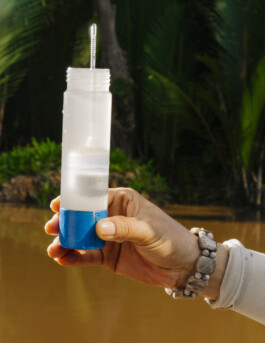
Salinity test southern Vietnam. The water in this part of the Mekong delta shows a salinity of over 15, which is even higher than the ocean‘s salinity. The increasing salinity in the Mekong Delta is currently being driven by the building of dams upstream and sand mining downstream.
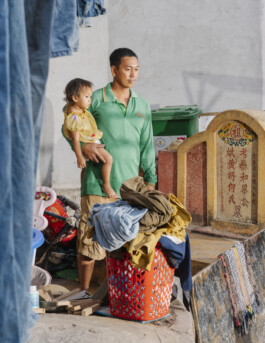
Father and daughter in Phnom Pen, Cambodia. Many of the residents of this neighborhood, which was built on an old cementery, had to move here after their houses collapsed into the Mekong.
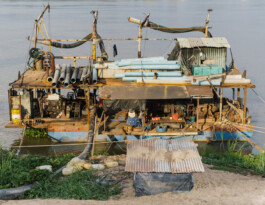
Sand farming boat in Phnom Penh.
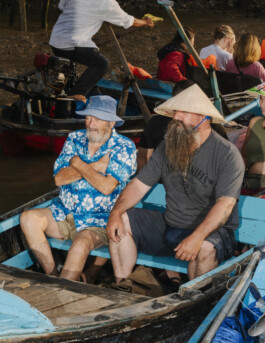
Tourists at the Phong Dien floating market in Can Tho, Vietnam. It used to be a busy places for sellers but now it's only shadow of itself. Some days, there are more tourists than vendors to be found.
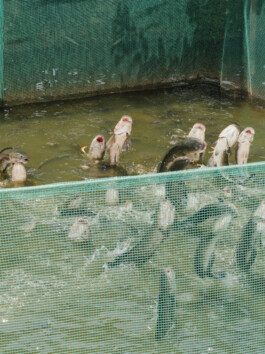
Fish farm in Con So Islet, Can Tho, Vietnam.
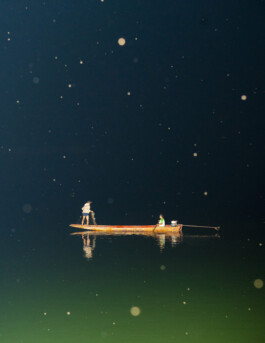
Fishermen at the Si Phan Don in Laos. Si Phan Don, meaning '4,000 islands,' is a riverine archipelago in the Mekong River, located in southern Laos, characterized by numerous islands, with historical and cultural ties to Cambodia and a growing tourism industry.
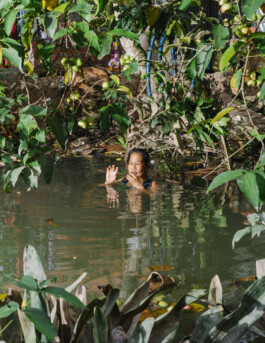
Woman bathing in a flooded area near her neigbourhood. In a recent flood, eight houses fell into the river.

Crocodile farm at Chong Khneas, Tonlé Sap.
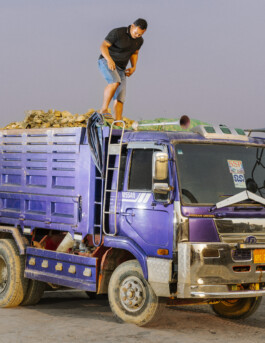
Worker moving sand at the ING City project, Phnom Penh, Cambodia. At the nexus of the Mekong and Sap rivers, Phnom Penh is endowed with hectares of lakes and wetlands that work as natural drainage systems during the six months of the rainy season. The Cambodian government is embarking on a number of ambitious development projects, which, according to critics, come at the expense of the environment and people’s livelihoods.
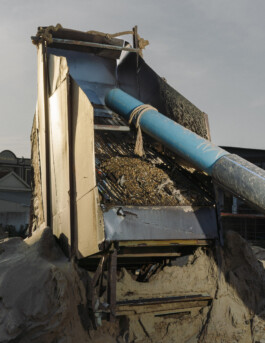
Sand Mining device in Phnom Penh. Phnom Penh’s construction frenzy is fueling the need for sand dredging, the practice of sucking up debris from riverbeds. The sand is normally used to clear waterways and provide material for development projects.
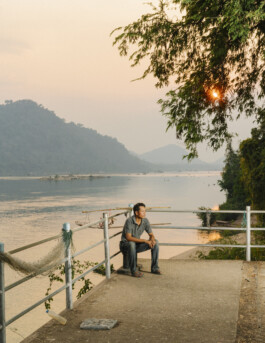
Khampha Srisuphan, a tourist guide in front of the transboundary pool between Cambodia and Laos in Don Det, where the freshwater dolphins used to live. He used to offer tours to watch the endangered river dolphins, but they have been extinct in the region since early 2022.
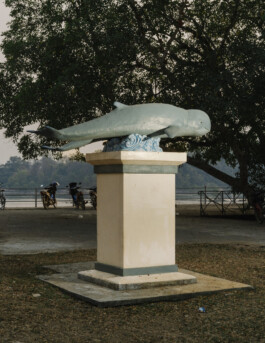
Statue in Don Det, Laos. In 2022, the last Irrawaddy river dolphin became entangled in fishing gear and died, signifying the extinction of the species in Laos.
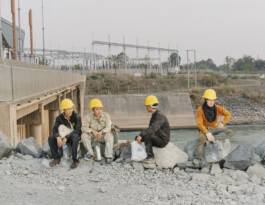
Construction workers in front of the Don Sahong Dam.
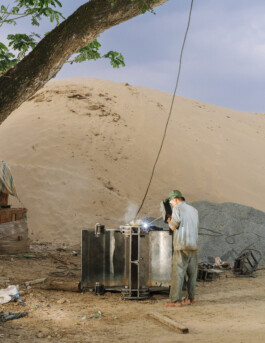
Metal worker in Can Tho, Vietnam. He is repairing an excavator arm used for moving sand out of the Mekong.
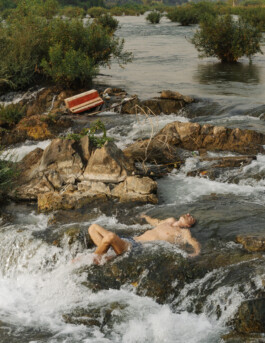
Tourist at Li Phi Somphamit waterfalls in Laos. These falls are known as the „spirit falls.“ Many Laotians believe the falls and rapids catch ghosts and spirits here.
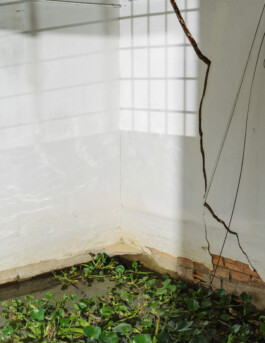
Abandoned house at Hoa Ninh Village, Vinh Long province, in Vietnam. After a flood, eight of nine houses fell into the river. This is the last one remaining in the settlement.
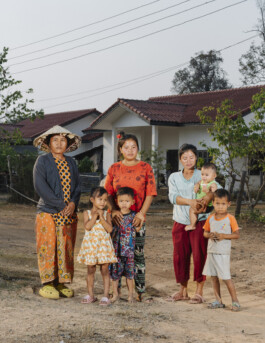
Villagers of Hang Sahong hamlet in Laos. They had to be relocated due to the construction of the Don Sahong Dam on whose expansion most of the young men from the village work.
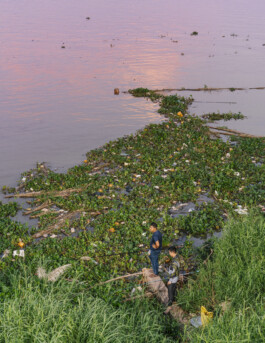
Fishermen in Phnom Penh, Cambodia.
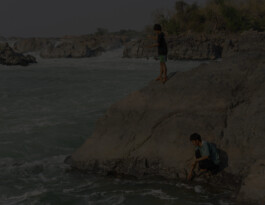
Mekong's Fight for Survival ↓


Prek Thi, Roka Kpos district, Cambodia. On January 17 2023, Prek Thi was affected by a landslide, with six houses collapsing into a creek and another requiring relocation.

Woman washing her hair in front of the Don Sahong Dam. The Dam, operational since January 2020, is a hydroelectric facility on the Mekong River in Laos, located near the Laos-Cambodia border. It exports most of its electricity to Thailand and Cambodia, despite controversy over its environmental impact and potential threats to fish migration routes and endangered species such as the Irrawaddy dolphin.


Monkey at a Mangrove Forest in the Mekong Delta. Mangrove deforestation is particularly devastating given the vital ecological role these forests play for surrounding communities.

Residents of New Kbal Romeas, near Stung Treng in Cambodia, were affected by the Lower Sesan II hydropower dam construction. Most were Bunong indigenous people, deeply connected to their land. Some relocated to this new settlement, while others resisted moving.

Monks in Phnom Penh, Cambodia, reside at the confluence of two vital tributaries, the Tonle Sap River and the Bassac, where they merge with the Mekong.

Thanh Tam Church in Rach Vop, Vietnam. After a landslide took part of the church into the Mekong, it was rebuilt and protected against erosion using mainly coconut trees. The big statue shows Saint Joseph and is intended to protect the church from future landslides.

Children from the Vietnamese community at Chong Khneas, Tonlé Sap, Cambodia. As stateless people, the ethnic Vietnamese on Tonlé Sap do not have the same protection and privileges as the citizens of Cambodia. They are not allowed to purchase land, their access to education is limited, and they are subject to arbitrary taxes and abuse by the local government. This denial of privileges results in a large population of stateless Vietnamese huddling in communities along the Tonlé Sap lake in floating villages.


Shrimp farm in the Tra Vinh province in Vietnam. This is the most downstream part of the Mekong delta, where coastal salinity intrusion and the river’s freshwater produces perfect conditions for shrimp farming. Over the last decade, agricultural industrialists and small farmers converted much of the delta’s coastal zone into shrimp farms. Like rice, the delta’s shrimp is sold all over the world.
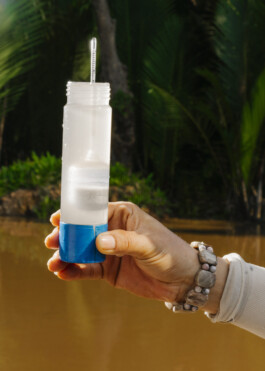
Salinity test southern Vietnam. The water in this part of the Mekong delta shows a salinity of over 15, which is even higher than the ocean‘s salinity. The increasing salinity in the Mekong Delta is currently being driven by the building of dams upstream and sand mining downstream.

Father and daughter in Phnom Pen, Cambodia. Many of the residents of this neighborhood, which was built on an old cementery, had to move here after their houses collapsed into the Mekong.


Tourists at the Phong Dien floating market in Can Tho, Vietnam. It used to be a busy places for sellers but now it's only shadow of itself. Some days, there are more tourists than vendors to be found.

Fish farm in Con So Islet, Can Tho, Vietnam.

Fishermen at the Si Phan Don in Laos. Si Phan Don, meaning '4,000 islands,' is a riverine archipelago in the Mekong River, located in southern Laos, characterized by numerous islands, with historical and cultural ties to Cambodia and a growing tourism industry.

Woman bathing in a flooded area near her neigbourhood. In a recent flood, eight houses fell into the river.

Crocodile farm at Chong Khneas, Tonlé Sap.

Worker moving sand at the ING City project, Phnom Penh, Cambodia. At the nexus of the Mekong and Sap rivers, Phnom Penh is endowed with hectares of lakes and wetlands that work as natural drainage systems during the six months of the rainy season. The Cambodian government is embarking on a number of ambitious development projects, which, according to critics, come at the expense of the environment and people’s livelihoods.

Sand Mining device in Phnom Penh. Phnom Penh’s construction frenzy is fueling the need for sand dredging, the practice of sucking up debris from riverbeds. The sand is normally used to clear waterways and provide material for development projects.

Khampha Srisuphan, a tourist guide in front of the transboundary pool between Cambodia and Laos in Don Det, where the freshwater dolphins used to live. He used to offer tours to watch the endangered river dolphins, but they have been extinct in the region since early 2022.

Statue in Don Det, Laos. In 2022, the last Irrawaddy river dolphin became entangled in fishing gear and died, signifying the extinction of the species in Laos.


Metal worker in Can Tho, Vietnam. He is repairing an excavator arm used for moving sand out of the Mekong.

Tourist at Li Phi Somphamit waterfalls in Laos. These falls are known as the „spirit falls.“ Many Laotians believe the falls and rapids catch ghosts and spirits here.
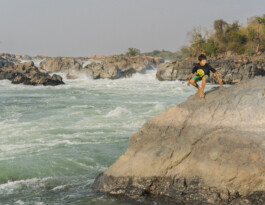

Abandoned house at Hoa Ninh Village, Vinh Long province, in Vietnam. After a flood, eight of nine houses fell into the river. This is the last one remaining in the settlement.

Villagers of Hang Sahong hamlet in Laos. They had to be relocated due to the construction of the Don Sahong Dam on whose expansion most of the young men from the village work.

Fishermen in Phnom Penh, Cambodia.